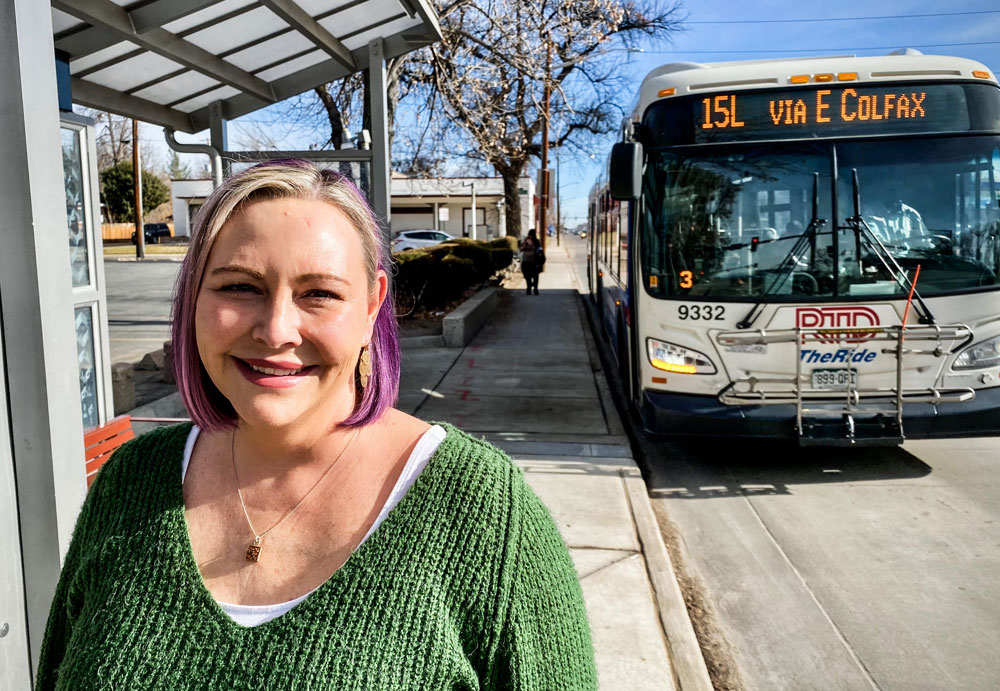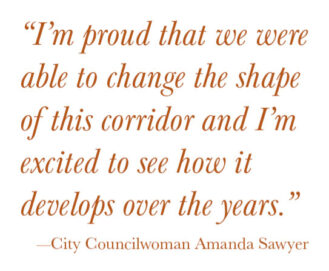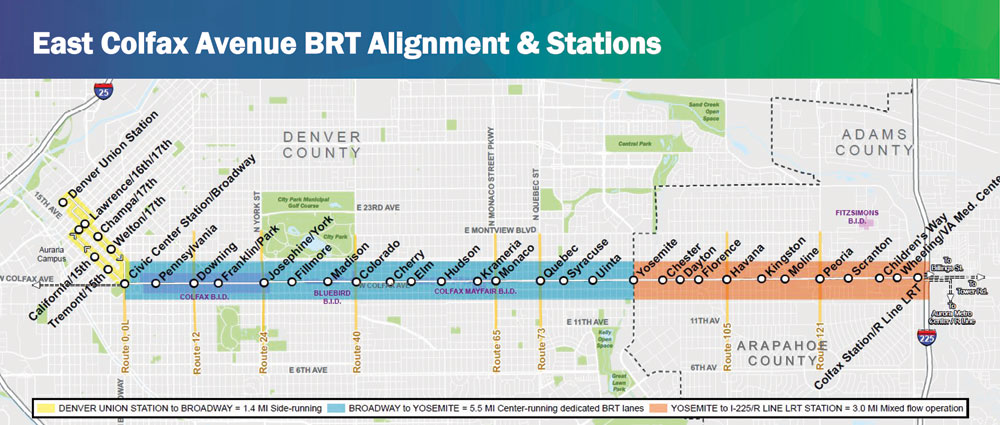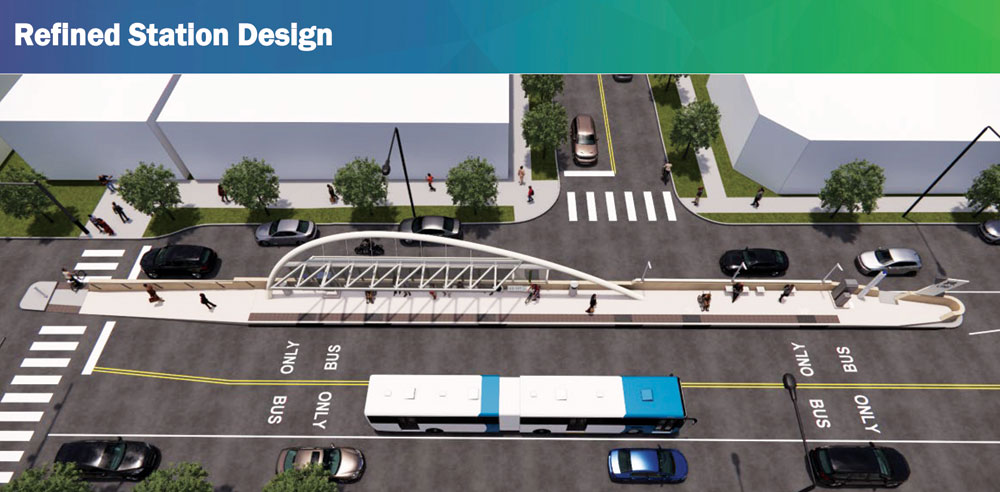
District 5 Councilwoman Amanda Sawyer is pictured at Colfax and Monaco, where council districts 5, 8, and 9 intersect. Sawyer co-sponsored the zoning bill that aims to turn the areas near BRT stations into vibrant commercial centers. Front Porch photo by Steve Larson
 Dramatic transformations will begin in 2024 designed to improve the conditions on East Colfax for commuters, pedestrians, businesses, and residents. Three major changes will facilitate the transformation. Denver will install a unique bus transportation system, a rezoning policy was passed to encourage a vibrant business environment, and an adaptive reuse program was implemented to revitalize old buildings. All of these changes intend to solve different problems, but all are working in conjunction to transform East Colfax.
Dramatic transformations will begin in 2024 designed to improve the conditions on East Colfax for commuters, pedestrians, businesses, and residents. Three major changes will facilitate the transformation. Denver will install a unique bus transportation system, a rezoning policy was passed to encourage a vibrant business environment, and an adaptive reuse program was implemented to revitalize old buildings. All of these changes intend to solve different problems, but all are working in conjunction to transform East Colfax.
The Bus Rapid Transit System
East Colfax will be the first road in Denver to offer a Bus Rapid Transit (BRT) system for residents. The system will provide two lanes for buses in the center of the corridor. Northeast Denver will have nine stops from Colorado to Yosemite, and buses will arrive at each station approximately every four minutes. Single car lanes on each side of East Colfax will still enable cars to drive in both directions along the corridor. The City expects the BRT project to break ground in 2024, for the construction phase to be complete in two years, and for the system to start operating in 2027.

Jon Stewart, BRT Project Director.
“People want to have additional transportation options besides just single-occupancy vehicles,” says Jon Stewart, the BRT project director. Stewart works for the Denver Department of Transportation and Infrastructure (DOTI), which is leading the development of the new system. “Our traffic study showed the time savings that passengers will get with the BRT. For the bus, the trip from Aurora all the way to Civic Center Station will be 30 minutes quicker.”
DOTI also hopes that reducing the number of cars on the road can decrease the levels of pollution in the air. “We keep hearing that we need to do something about climate change, and so this can give us a way to reduce greenhouse gases and our carbon footprint,” says Stewart.
Improved safety was another motivation for the BRT system. “We want to find a way to make transportation safer because Colfax is one of the most dangerous streets in Denver. Transit is a much safer way of getting around the city, a lot less people are killed in buses than single-occupancy vehicles, and so the BRT is a tremendous opportunity to increase safety on this corridor.”
Additionally, DOTI believes the transit system can provide economic benefits for local businesses. “We’ve talked to several other transit agencies that have implemented similar projects, and across the board we see an economic stimulus occur,” says Stewart.

The new BRT stops along Colfax from downtown Denver to I-225 will speed up commute times, with buses arriving at stations every four minutes. Construction will begin in 2024 at the west end and gradually progress eastward.. Map from www.denvergov.org
The East Colfax Rezoning Bill
City Council recently passed a bill to change the zoning codes for all new developments located within two blocks of BRT stations. Officially named Active Centers and Corridors Design Overlay, the new zoning is being referred to as DO-8. The primary goals of the bill are to convert the areas around the stations into commercial centers for businesses and to transform East Colfax into a walkable corridor for pedestrians. Denver’s “overlay zoning” keeps original zoning provisions and “overlays” them with new zoning standards (though the overlay may in some cases require a variance to the original zoning).
“It made sense to put the rezoning standards where the BRT stops are located, so I’m proud that we were able to change the shape of this corridor and I’m excited to see how it develops over the years,” says City Councilwoman Amanda Sawyer, who represents District 5 and who co-sponsored the bill with Councilman Chris Hinds.
Certain provisions in DO-8 attempt to improve the walkability of the corridor. East Colfax has many car-oriented areas that are sprawling with empty lots, drive-thrus, gas stations, car washes, auto dealerships, and storage facilities. However, the zoning changes prohibit new car-oriented projects from developing near the stations and only allow pedestrian-friendly businesses to open in those areas. Additionally, setback changes require new projects to be placed two feet further from the street to provide more space for pedestrians on the sidewalks.

BRT stations will have raised platforms for easier boarding, ample lighting, covered seating, ticket vending machines, and electronic schedule displays. Buses will have three sets of double doors for quicker boarding and the vehicles will communicate with traffic signals to get priority for green lights to speed up commuting times. Cars will still have opportunities to make left turns. Illustration from www.denvergov.org
DO-8 also aims to turn blocks near the stations into bustling commercial centers with activities for residents, jobs for workers, and customers for businesses. Two changes to the design standards can help achieve that goal. The ground levels of all new businesses near the stations must have an active commercial use and be at least 14 feet high. “The design standards can open up the space of the storefronts and help enhance the feel for people walking or riding along the corridor,” says Sawyer. “When we have larger ground floors with big windows, it makes it more welcoming as a vibrant space and gives East Colfax a main street environment.”
The overlay faced opposition during its development. Some opponents claimed that the bill was too strict, arguing that the new rules would be difficult for developers to accommodate. Other opponents believed the overlay was too lenient, citing that the bill does not apply to areas that are further away from BRT stations. But supporters contend that the zoning changes served a beneficial purpose for East Colfax.
“We want housing along the corridor,” says Sawyer. “We want nodes to attract businesses in places where people are getting off at BRT stops, but we didn’t have the overlay cover the entire corridor because we also want space to build housing in those other areas. We need the housing for our residents, businesses need people to come to their stores, and so we needed to strike a balance when building out the density along Colfax.”
Although residents expressed concerns about the new zoning, City Council unanimously passed DO-8 on Dec. 13.
The Adaptive Reuse Program
An adaptive reuse program was also recently implemented on East Colfax. This program helps owners of old properties convert their buildings into residential housing units or active commercial businesses. The program is operated by the Denver Department of Community Planning and Development. The first adaptive reuse program was implemented earlier this year to utilize vacant buildings in downtown Denver, and in November the City enacted another adaptive reuse program to convert old buildings on East Colfax.

Jennifer Ramsey, Denver Adaptive Reuse Administrator
“A benefit of the East Colfax program is that we’re trying to preserve that neighborhood identity by reinvigorating those historic structures,” says Jennifer Ramsey, a Central Park resident and the adaptive reuse administrator for Denver. “Construction along East Colfax used methods we don’t do anymore, so there was a lot of community interest in maintaining the existing neighborhood character, especially with the changes for the BRT and needing to add a higher density of residential housing and small businesses.”
The adaptive reuse program applies to buildings on East Colfax that are at least 30 years old and that are located between Broadway and Yosemite. The City offers services to help owners convert their buildings for active residential or commercial uses. “We can assist businesses through the review and permitting process,” says Ramsey. “We can guide them through the timeline schedules, regulatory barriers, communication problems, or financial roadblocks. Adaptive reuse can be trickier than traditional development, so it helps to get the information and understand the steps.”
Eligible property owners on East Colfax who want to convert their old buildings can visit the website at Denvergov.org/AdaptiveReuse or email Ramsey at Jennifer.Ramsey@denvergov.org



I would appreciate a reply.
The article in Front Porch (January 2024, pp 4-5) shows a map with a raised platform for bus riders to stand on while they wait and then enter the BUS RAPID TRANSIT. However, the platform is next to only the BRTs going east on Colfax, and has a wall on the back of the platform. Where do people stand who want to ride the BRT going west? Why are there not two BRT lanes, one on each side of the platform, so passengers can exit the same side of the bus going east and west? Or do the buses weave back and forth going to alternate stops, threatening head on collisions?
Jon Stewart, BRT Project Director at Denver Department of Transportation and Infrastructure, is quoted as saying: “Our traffic study showed the time savings that passengers will get with the BRT. For the bus, the trip from Aurora all the way to Civic Center Station will be 30 minutes quicker.” The chief argument for the new plan is saving time.
How is this possible? Google Maps, and the RTD website show the current 15L time from Colfax Station (I-225, zip code 80111) to Civic Center Station, is 38 minutes. If the bus were 30 minutes quicker, buses would take 8 minutes, averaging over 60 miles per hour while serving 27 stops.
From our editor Brian Heuberger:
Thank you for the insightful questions, and we’d be glad to provide additional details. The East Colfax BRT system features single-direction bus stations. The riders going eastbound will have their own station platforms where they can enter or exit the buses, and likewise the riders going westbound will stop at separate stations on the other side of the intersections. Those single-direction stations are intended to improve the efficiency of the buses and the safety of the riders.
Also, the traffic study that DOTI used considered several factors, including the average times during rush-hour traffic and low-volume traffic. But the study also projected the potential impacts of the new changes, such as the additional buses, the dedicated center lanes, and the stoplight priorities. As a result, the study predicted that the commute time for drivers on East Colfax might be increased by three minutes, but that riders on the buses can expect an average reduction of approximately 30 minutes.